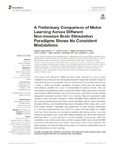Mostrar o rexistro simple do ítem
A preliminary comparison of motor learning across different non-invasive brain stimulation paradigms shows no consistent modulations
| dc.contributor.author | López-Alonso, Virginia | |
| dc.contributor.author | Fernández-del-Olmo, Miguel | |
| dc.contributor.author | Cheeran, Binith | |
| dc.contributor.author | Sandrini, Marco | |
| dc.contributor.author | Abe, Mitsunari | |
| dc.contributor.author | Cohen, Leonardo | |
| dc.contributor.author | Liew, Sook Lei | |
| dc.date.accessioned | 2024-01-17T18:03:22Z | |
| dc.date.available | 2024-01-17T18:03:22Z | |
| dc.date.issued | 2018-04-23 | |
| dc.identifier.citation | Lopez-Alonso V, Liew S-L, Fernández del Olmo M, Cheeran B, Sandrini M, Abe M and Cohen LG (2018) A Preliminary Comparison of Motor Learning Across Different Non-invasive Brain Stimulation Paradigms Shows No Consistent Modulations. Front. Neurosci. 12:253.doi: 10.3389/fnins.2018.00253 | es_ES |
| dc.identifier.issn | ISSN: 1662-453X | |
| dc.identifier.uri | http://hdl.handle.net/2183/34964 | |
| dc.description.abstract | [Abstract]: Non-invasive brain stimulation (NIBS) has been widely explored as a way to safely modulate brain activity and alter human performance for nearly three decades. Research using NIBS has grown exponentially within the last decade with promising results across a variety of clinical and healthy populations. However, recent work has shown high inter-individual variability and a lack of reproducibility of previous results. Here, we conducted a small preliminary study to explore the effects of three of the most commonly used excitatory NIBS paradigms over the primary motor cortex (M1) on motor learning (Sequential Visuomotor Isometric Pinch Force Tracking Task) and secondarily relate changes in motor learning to changes in cortical excitability (MEP amplitude and SICI). We compared anodal transcranial direct current stimulation (tDCS), paired associative stimulation (PAS25), and intermittent theta burst stimulation (iTBS), along with a sham tDCS control condition. Stimulation was applied prior to motor learning. Participants (n = 28) were randomized into one of the four groups and were trained on a skilled motor task. Motor learning was measured immediately after training (online), 1 day after training (consolidation), and 1 week after training (retention). We did not find consistent differential effects on motor learning or cortical excitability across groups. Within the boundaries of our small sample sizes, we then assessed effect sizes across the NIBS groups that could help power future studies. These results, which require replication with larger samples, are consistent with previous reports of small and variable effect sizes of these interventions on motor learning. | es_ES |
| dc.description.sponsorship | This work was supported by the National Institutes of Health (NIH) National Institute of Neurological Disorders and Stroke (NINDS) Intramural Competitive Research Award (S-LL) and Intramural Research Program (LC and S-LL), the National Center for Medical Rehabilitation Research (NCMRR) Extramural Program (K01HD091283 to S-LL) | es_ES |
| dc.description.sponsorship | Ministerio de Educación, Cultura y Deporte of Spain (FPU fellowship to VL-A) | es_ES |
| dc.language.iso | eng | es_ES |
| dc.publisher | Fronteirs | es_ES |
| dc.relation.uri | https://doi.org/10.33589/fnins.2018.00253 | es_ES |
| dc.rights | Atribución 3.0 España | es_ES |
| dc.rights.uri | http://creativecommons.org/licenses/by/3.0/es/ | * |
| dc.subject | non-invasive brain stimulation | es_ES |
| dc.subject | motor learning | es_ES |
| dc.subject | transcranial direct current stimulation (TDCS) | es_ES |
| dc.subject | paired associative stimulation (PAS) | es_ES |
| dc.subject | theta burst stimulation (TBS) | es_ES |
| dc.subject | power analysis | es_ES |
| dc.title | A preliminary comparison of motor learning across different non-invasive brain stimulation paradigms shows no consistent modulations | es_ES |
| dc.type | info:eu-repo/semantics/article | es_ES |
| dc.rights.access | info:eu-repo/semantics/openAccess | es_ES |
| UDC.journalTitle | Frontiers in Neuroscience | es_ES |
| UDC.volume | 12 | es_ES |
Ficheiros no ítem
Este ítem aparece na(s) seguinte(s) colección(s)
-
II - Artigos [568]






